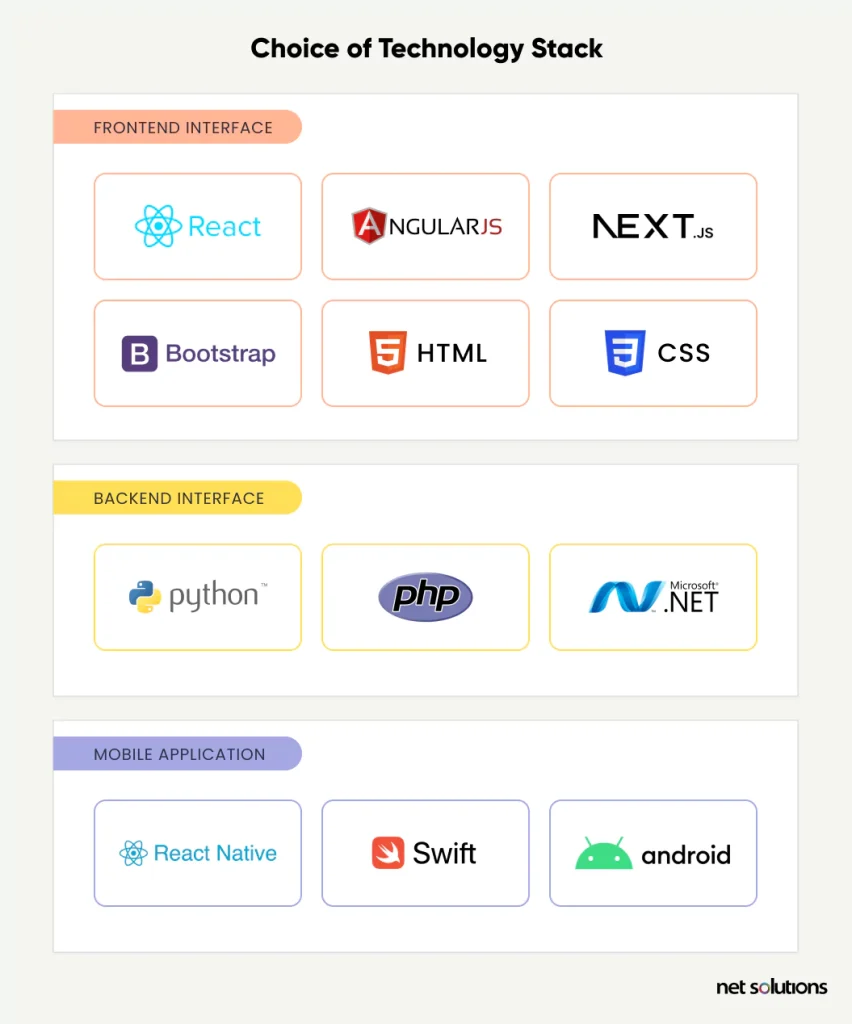The Minimum Viable Product (MVP) approach to software development has a variety of benefits, and cost-effective design and development is chief among them.
So, how much does an MVP cost? A Google search will reveal a wide range: $10,000 to $100,000+ to create an MVP, which isn’t very helpful, we know.
Don’t worry, though! We’re going to demystify everything by providing examples of 7 MVPs that we built here at Net Solutions, and we’ll identify the rough costs to build something similar in today’s dollars (see the chart).
We’ll also explore the different factors that affect the price, along with average costs for outsourcing MVP development to different regions of the world.
Note: We’re specifically addressing costs associated with developing a high-fidelity, working-model MVP, as opposed to a low-fidelity MVP, such as an MVP website or landing page.
Real Examples of MVPs + the Cost to Build a Similar Product (in today’s dollars)
The best way to get a sense of MVP pricing is to look at real-world examples of MVP projects and their associated costs. And since we’ve developed quite a few MVPs over the years, we can draw from real examples of products we created for our clients.
Keep in mind that we’ve estimated the following cost ranges based on what competent, experienced teams around the world tend to charge for something similar. Specifically, that means end-to-end MVP design, development, MVP testing, etc.
Costs will vary based on skill set, experience, scope changes, and the location of your outsourcing partners, of course. We also list how much we would roughly charge for a similar MVP if we were to design and build it from scratch today.
If you want to dig deeper into the original projects and see what we did for each client, click on the links in the first column to read the case studies.
| Company | Industry | Description | Approximate full-service outsourcing costs for a similar MVP | Approximate Net Solutions price for a similar full-service MVP creation |
|---|---|---|---|---|
Duelo | Sports & Entertainment | Online sports betting app | $390,000 – $425,000 | $130,000 – $150,000 |
VoyLegal | Recruiting & Legal | Recruiting app for law firms and companies hiring attorneys | $450,000 – $600,000 | $150,000 – $200,000 |
Appee | Marketing Technology | Analytics-driven survey platform to assess customer engagement | $150,000 | $100,000 |
EMR | Healthcare | Decision-making app for healthcare professionals | $50,000 | $25,000 |
Avance | Education & Training | Corporate training app to help employees develop soft skills | $120,000 | $60,000 |
Scoff | Dining & Entertainment | Double-sided marketplace where chefs and restaurants can sell food to hungry customers in London | $450,000 | $150,000 |
RedStateDate & BlueStateDate | Media and Entertainment | Two dating apps (with the same design format) for Americans looking to date within their own political party | $90,000 | $45,000 |
Factors Affecting MVP Cost
Now that you’ve got a general sense of the costs required to build different types of MVPs, let’s explore the factors that move the needle on price. Many of these factors are within your control to a large degree, but price shouldn’t be your only criterion.
Your most important aim is to create a high-quality, usable MVP that delivers your product’s core functionality, helps you validate your ideas, and uses the right technology to enable scaling.
With this in mind, here are seven key factors that affect MVP development costs, followed by some hidden costs that many don’t consider when building an MVP.
Complexity and number of features
The most important factor determining the price of software development, and MVP app development in particular, is the product’s complexity and its number of features. Since MVPs are relegated to core features, they will cost less than a similar full-fledged product with a wide range of features.
On a fundamental level, product complexity is tied to things like the number of screens a user will encounter (since each screen requires labor) along with each feature’s front-end and back-end requirements.
Since each feature takes time and labor to design and build as well, a budget-conscious app only includes what’s necessary to validate an idea and gather feedback.
Choice of technology stack
The technology stack you choose in the beginning is not only a key factor in determining initial costs, but it will impact future costs as you scale. That’s why choosing the right tech stack for your project is essential.

A few factors to consider when it comes to choosing your tech stack are:
- Your tech team’s experience working with the technology you choose
- Maintenance requirements for your tech stack
- Your tech stack’s scalability
- Your product’s tech requirements (based on size and complexity)
- Security requirements
If you’re not sure which tech stack to choose, don’t be afraid to consult outside resources. Even if you have a large in-house development team on staff, it never hurts to get an outside opinion on your tech requirements. Getting it right the first time is important because changing your tech stack late in the game can be time-consuming and expensive.
UI and UX design complexity
The User Interface (UI) design for MVPs tends to be relatively simple, but it should still be clean, attractive, and effective. The idea is that users intuitively understand what they need to do to accomplish their aims. Naturally, the UI feeds into the MVP User Experience (UX), which should incorporate best practices so users have a pleasant, hassle-free experience using the product.
Creating a UI and UX for your MVP means testing design concepts with your target audience, using prototypes, before building the product. That will give you a sense of what works and what needs to change.
Now, there are certain circumstances where a more complex UI and UX are necessary to make your product truly viable. Some products are more complex than others, and they may require a more sophisticated interface, which naturally demands more sophisticated UX design.
The trick is to make it as simple as you can without impacting core functionality and ease of use. That will allow you to validate your idea and gather meaningful user feedback.
Composition and location of the development team
Are you planning to build an in-house team that handles product development from start to finish (including business analysts, UX researchers, project managers, and more)?
Are you thinking of hiring freelancers? Are you considering outsourcing part or all of the project to a full-service software development company? All these factors will impact your costs to design, build, launch, and test your MVP.
If you’re thinking about outsourcing any part of your MVP, then going international (i.e., offshoring) can offer powerful savings and real value if you work with an experienced firm. The following chart breaks down hourly rates for software development in different parts of the world, but keep in mind that there’s a lot of variation within each region.
To learn more about the cost of MVP development across the globe, check out our blog post that covers cost comparisons for software development rates in different countries.
| Region | Average Hourly Rate |
|---|---|
| Asia | $33 |
| Eastern Europe | $66 |
| Western Europe | $149 |
| Africa | $39 |
| Latin America | $41 |
| North America | $182 |
| Oceania | $127 |
Timeline
A straightforward MVP can often be ready for launch within a month or two, but the degree of complexity will naturally impact the timeline. Now, if you’re looking to expedite the process, many software development firms can make that happen, but it will naturally increase the costs.
Why does reducing the timeframe increase cost estimates? Simply put, you’ll need more resources to expedite the development process—more designers, rapid market research, more developers, more testers, and greater oversight from project managers.
The good news is that if you’ve got strategic reasons to shorten the development time, many companies that offer MVP development services can make it happen.
Integration requirements
Will your MVP require complex integrations with external apps or third-party services? If so, that will likely increase app development costs.
In this case, your development team will probably need to build APIs, engage in data mapping, and perform other tasks to ensure that everything works seamlessly and that the app meets minimal user expectations.
Scalability and performance requirements
Some MVPs don’t have massive performance requirements since entrepreneurs sometimes test the first version of their product on a small number of users, as Uber did with its initial app idea. For its MVP, Uber used an invite code that users could share with their friends, ensuring they only needed to handle a small number of requests in the beginning.
Other MVPs are made available to the public immediately, which means their user base might scale quickly. These apps have higher performance requirements for handling the potentially large influx of traffic, which means they may require a different tech stack.
It naturally follows that the higher the scalability and performance requirements you’ve got, the more it will impact the cost of building your MVP.
By the way, if the Uber story piqued your interest, we wrote a whole post featuring examples of MVPs from famous companies.
Hidden Costs in MVP Development
In addition to the factors listed above, there are a number of costs associated with MVP design, development, and launch that may come as a surprise. Be sure to control these costs where you can and factor them into your budget when they’re unavoidable.
Scope creep: As designers and developers dive into a project, it may be tempting to start adding new features, expanding the scope of the original vision. Successful MVP development means keeping an eye on scope creep and learning to say “no” to keep your scope of work in check.
Regulatory compliance: Adhering to regulations specific to certain industries and regions can raise the budget, but ignoring them could sink your company. Be sure to explore all potential regulatory hurdles (e.g., GDPR for data, HIPAA for U.S. healthcare) when determining your budget.
Security concerns: Security is vital when building an MVP, especially if you’re going to be handling customer data or conducting transactions. Be sure to factor security into your initial costs.
Marketing: Marketing may be an important part of your launch strategy, so factor in those costs as well.
If you have any doubts about whether you’ll incur these costs or how to mitigate them, consult an experienced development team before finalizing your budget.
Cost-Effective Strategies for Building an MVP
Now that we’ve covered the various costs associated with building a Minimum Viable Product, let’s dive into some techniques for keeping those costs in check without sacrificing quality.
Prioritize the essential features
Feature prioritization is important when building any software product, but it’s absolutely essential when it comes to creating an MVP. For MVP feature prioritization, return to your marketing research and focus on the problem you intend to solve.
How does your solution differ from existing products on the market? Based on your customer surveys and interviews, are you offering a unique way of solving that problem that others on the market haven’t tapped into?
As tempting as it may be to include a bunch of features, focus only on the most important ones. Keep a log of features you may want to include down the line, and prioritize low-risk/high-reward features in future iterations—assuming they align with what your users want out of your product.
Leverage open-source tools, libraries, and frameworks
Open-source tools, libraries, and frameworks are free for everyone to use, and you can save a great deal of money if you’re working with a development team that knows how to use them.
Of course, in some cases, those open-source tools may fall short compared to paid solutions, and you don’t want to sacrifice your ability to scale or integrate additional software for modest savings. That’s why each decision you make regarding your tech stack should involve a careful cost-benefit analysis.
Use ready-made design templates or UI kits
Ready-made UI kits are collections of design elements used to build user interfaces in software applications. They consist of things like buttons, icons, forms, style sheets, and more.
Design templates and UI kits can cut MVP development costs since you don’t have to pay for the labor required to create those elements. If you want to create a more custom solution once you’ve validated your MVP, that’s always an option, but high-quality UI kits can get you started and save you money.
Remind your team: MVPs adopt an iterative approach to development
It seems obvious, right? The very nature of an MVP involves an iterative approach to software design and development. However, it’s easy for designers and developers to get excited about what they’re doing and go overboard. In fact, that’s exactly how scope creep kicks in.
Strong project management skills and regular, open communication will help keep everyone on track. Make sure your team understands that they’ll have plenty of opportunity to build out the product once you’ve validated the idea and gathered feedback.
Outsource MVP development
Outsourcing software development to an experienced, talented partner is always a good way to save money without sacrificing quality. That’s because in-house employees are a lot more expensive than outsourcing due to hidden costs (e.g., benefits, payroll taxes, sick leave) and higher costs of labor in fully industrialized countries.
Hiring an outsourcing partner to build your MVP (or contribute to key portions of it) will also save time indirectly if you work with a development team that has built plenty of MVPs. They know the territory, they understand the common pitfalls, and they can guide you and your team to success.
Looking for a realistic price quote for your MVP?
Net Solutions has designed and developed countless software products (desktop and mobile app MVP development) for household names like the Harvard Business Review and IMG. We’ve also spearheaded plenty of MVP projects for startups and enterprises alike, which we highlight in the chart above (with links to each case study).
Net Solutions can help with every element of MVP creation and launch: Market research, user testing, UX and UI design, development, QA testing, MVP launch, MVP testing, maintenance, and post-launch iterations.
Contact us today for a free consultation, and learn what it will cost to bring your MVP to life.
SHARE THIS POST
Table of Contents
Related Resources
- What Is an MVP App? A Guide to Building Successful Products
- A Deep Dive Into 7 Minimum Viable Product Benefits
- A Step-by-Step Guide to Build a Minimum Viable Product (MVP)
- 19-Step Minimum Viable Product (MVP) Checklist [With PDF]
- 10 Top MVP Development Companies [Great for Startups]
- 10 Minimum Viable Product (MVP) Examples You Should Know
- The Ultimate Guide to Developing an MVP in Agile: What, How, and Why
- A Step-by-Step Guide on how to Master Your MVP Launch in 2025
- How to Prioritize Features for Your Minimum Viable Product (MVP)
- How to Test an MVP: 15 Proven Strategies that Work
- 20 Great MVP Tools to Help You Create & Launch Your Product
- 11 different Types of MVPs to Kickstart Your Software Project
- How to Nail MVP Design with UX Design Principles that Work
- MVP Website: Benefits, Best Practices, How to Build & More


